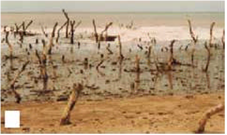Parineeta Dandekar
Extreme water logging and flood situation in channelized areas in Pune - A report
Posted on 13 Oct, 2010 04:32 PMGuest post by Parineeta Dandekar
While this news item was about to be published, Pune received heavy rains on the 4th of October (highest in the last 118 years, 104 mm in 40 minutes and 181.3 mm in 24 hours). While the city administration stressed that this was a cloud burst, this claim was quashed by the Indian Meteorological Department (IMD). This was said to a rare event, which was experienced in many places in Maharashtra.
10 people lost their lives to these rains, including three young children and a 25 year old Ph D researcher, Agnimitra Bannerjee, from National Chemical Laboratory, who was washed away in a channelised nallah stretch. Channels prove to be much more dangerous as the velocity of water is high and there is nothing to hold on to, in case a person falls in one of these fast-flowing nallah channels.
Environmental flows: Free-flowing rivers around the world
Posted on 30 Jul, 2010 11:56 AMThis is the first in a new series of articles that IWP will host on various aspects of Environmental Flows. We welcome your comments and original articles for this series, please mail us at portal@arghyam.org
The other side of the story: Free-flowing rivers around the world
With around 5100 large dams, India ranks third in the world with regards to the number of large dams. The ongoing debate over the economic, social and environmental costs of large dams has indicated many times that these costs are not commensurate with their benefits. Although we have dammed all our major rivers, (except Brahmaputra and plans to dam its major tributaries are on way, some like Ranganadi have already been dammed), profoundly changing their hydrological, ecological, social and cultural systems, we are yet to form a policy which states that environmental flows in rivers are a necessity. It is more than clear now that environmental flows relate to well being of not only ‘birds and fishes’, but also of the entire human society . Take an example of fisheries, lack of flows in rivers and contractor-owned reservoir fishing has affected the livelihood of hundreds of thousands of small fishermen . Environmental flows also dilute pollution load, so let us not hide behind the fact that pollution is wiping out our riverine fish, not the absence of flows. It is also clear that environmental flows do NOT mean a decommissioning of all the present dams, nor do they mean any random figure like 60% or 10% of MAR . Eflows require reaching a wise compromise through science and local negotiations, for each river.
While many countries have put in place policies and laws for maintaining environmental flows in their rivers, there is also a rarer category: Rivers which have not been dammed yet, rivers which retain their connection from the source to the sea, nurturing myriad ecosystems and communities in their wake! These are known by many names like Free flowing rivers, Wild Rivers, Pristine/ Virgin rivers, Heritage Rivers, etc., each indicating their rare character and value. In ecological and cultural terms, the value of these rivers is immense and as more and more rivers are being dammed the world over, this value is increasing steeply. Unfortunately, in today’s economic terms, these rivers are still waiting to get their due recognition, but as human systems evolve, they will surely be seen as ‘invaluable’ service providers with phenomenal use and non use values.
Resources: Water & sanitation for the flood affected
Posted on 13 Sep, 2008 09:43 PMParineeta Dandekar spent some time to find resources on the web for people involved in relief efforts in flood situations.The following provides a concise look at precautions, useful resources and general tips regarding drinking water, sanitation, relief measures in the flood affected regions. Water and Sanitation during floods: Some resources for relief workers and flood affected population With more than 300,000 people in relief camps and two mega relief camps planned in Bihar, consideration of issues related to water and sanitation is urgent. Epidemics and water borne diseases can spread rapidly and easily in the present situation.The information below is collected from various sources and aims to help of flood affected population, people in relief camps, volunteers, relief workers working in Bihar. Relief and aid workers should take the necessary precautions to assure their health and safety while working on rescue and clean up procedures. While conducting rescue and clean up operations, it should be assumed that the all surfaces have been contaminated with disease-causing organisms. This important assumption must be considered in decisions involving personal safety of rescue and cleanup personnel . ( for more information, please see here) Personal Protection Measures ( For more information, please see here)
Download the resource document as a doc file: Water & Sanitation for the Flood Affected
Environmental flows for Indian rivers:Need for a discussion to consider the health of the riverine ecosystems
Posted on 24 Apr, 2008 11:58 PMIndia is facing a water crisis in nearly all the sectors. Fortunately or unfortunately, measures taken by the related authorities to combat the crisis often depends on the amount of 'noise' made by the relevant stakeholders. It is no wonder then, that the urban India, and especially the rich and the powerful in urban India, seldom have to face problems related to water scarcity, water quality or the sheer inequity in distribution. On the other hand, weaker the stakeholder, more severe are his ( rather 'her') problems. Marginal farmers, tail enders in a canal network, rural and urban poor, especially children and women, stand testimony to this situation. We all agree to this, right? 
Godavari delta, destruction of mangroves
But aren't we forgetting the the weakest, and in some ways, the strongest, of all the stakeholders? How about the ecosystem of the river itself??